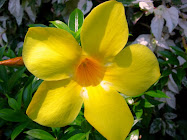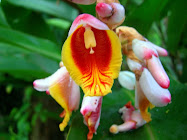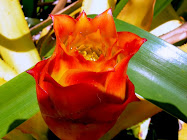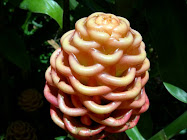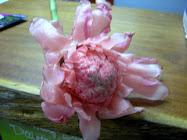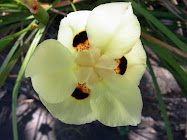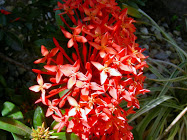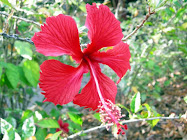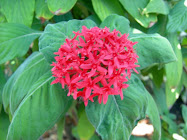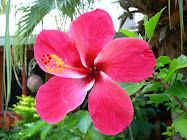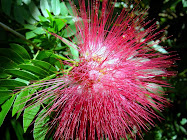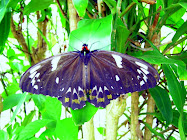Sunday 28 September
Afternoon Tea
All too soon it was time to leave and head back to the boat for the journey back to Port Douglas. Afternoon tea was served (again by the First Mate) - wonderful biscuits and of course tea and coffee.
Low Island
A last look at the island as we slowly made our way back to Port Douglas. I hadn't noticed the bird until after taking the photo.
Watching the Boats
People were sitting outside along the water just looking at the view. The chap on the left in a white top has his camera out.
Setting Sun
It was magical - slowly sailing with the setting sun, sipping champagne.
Sunset Sailing
The still sounds of night and the beauty of the sunset, the gentle ding-ding of the bell ringing as we approached Dixon Inlet and the Marina. A wonderful end to a glorious day. I was a little sad - I wished the day could go on forever. Of all the cruises and trips I've done, this one stands out as an unforgettable and beautiful memory.
The Crew
Back at the Marina, the journey is over - a wonderful ending to a beautiful day. I asked the Skipper could I have a photo with him and the First Mate - he gracously agreed.
Tropical Far North Queensland
This is about my holiday from Cairns to
Laura, on the lower Cape York Peninsula from
September 2008 to October 2008. Going from Melbourne to Cairns to Port Douglas, to Cooktown and Laura, Cape Tribulation and all the bits in between, and finally back to Cairns for my flight home.
Cheers.
Laura, on the lower Cape York Peninsula from
September 2008 to October 2008. Going from Melbourne to Cairns to Port Douglas, to Cooktown and Laura, Cape Tribulation and all the bits in between, and finally back to Cairns for my flight home.
Cheers.
Drive The Daintree
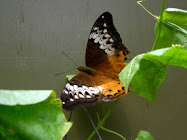
36. Low Isles - Island Walk
Sunday 28 September
The Low Isles are a Marine National Park Zone. Day visitors can come to the island via a number of commercial operators. There is a lagoon where private vessels can moor or anchor overnight, but there is no overnight accommodation on the island. There is a weather station, a lighthouse and the University of Queensland's research station.
There are two islands - Woody Island and Low Island, but it is to Low Island that the visitors come. Low Island is a "typical" tropical island - just like you see on the movies. It is a smaller vegetated, sandy, coral cay surrounded by 55 acres of reef.
Low Isles Map
No fishing is allowed in the lagoon or within a buffer zone around the islands.
Personal Palms
There are several shady palms - you get your own personal palm. One had two maroon chairs which are "reserved" the the crew - the Skipper and the First Mate!
Around The Island
I did a nature walk around the island. Low Isles are low, wooded islands, an island type unique to the GBR. The story begins around 7,000 years ago.....
As rising sea slowly covered the top of an ancient reef, dead corals were swept onto the reef flat. Heavy fragments settled on the windward side, building up a barrier. Mangrove seeds established in behind the barrier and Woody Island was formed.
Finer coral fragments were blown onto the sheltered corner of the reef flat. A low sandy cay emerged - Low Island.
Shady Trees
With their heavy cloak of vegetation, the islands are home to many birds - Osprey, Varied Honeyeater, Pied Imperial Pigeon, Sooty Oyster, White-Breasted Woodswallow, Mangrove Kingfisher.
Palms
In 1992 local people mindful of their neighbourly responsibilities, formed the Low Isles Preservation Society to protect Low Isles and promote reef research and education.
Many years of habitation has left its mark on Low Island - coconuts are more plentiful than on a "pristine" cay and exotic plants bear witness to diligent gardening by previous residents. Some exotic plants brought to the island include Singapore Daisy, Frangipani and Hibiscus. Today, Low Island is managed to prevent further imapacts, especially from visitors to this special place.
Low Isles Lighthouse
The Low Isles tower (1878) was constructed on a timber frame with a galvanised sheath in the typical Queensland fashion, and it was the first to have porthole windows. . Attached to the top was a 1.5m diameter lantern manufactured by Chance Bros of Birmingham, England.
A timber staircase gives access to the lantern room. The tower was painted white with a red dome. All the buildings were prefabricated elsewhere and transported and assembled on site.
The final cost of the lightstation was: capital cost of buildings - £4,090, cost of optical apparatus- £1,389. The island the tower is now controlled
by Queensland Parks and Wildlife.
Lighthouse
The Low Isles Lighthouse is on a low flat coral cay surrounded by thick vegetation. You can read further information and history here.
Research Station
The University of Queensland's Low Isles Research Station was previously the assistant lighthouse keeper's house. The research station consists of one house only, with good laboratory facilities located below, and can accommodate a maximum of 6 scientists.
Low Isles Research Station works closely with the ecotourism vessel Undersea Explorer, supporting quality research projects, promoting field work opportunities for University students and providing an exciting and stimulating reef adventure for scientists and students.
Shed
The shed is part of the research station.
Island View
Back to where I started. It was lovely strolling around the island - no noise save for the sound of birds and the leaves rustling in the gentle breeze. No smelly polutants, just clean, fresh air with the sun on your face and a feeling of timelessness.
The Low Isles are a Marine National Park Zone. Day visitors can come to the island via a number of commercial operators. There is a lagoon where private vessels can moor or anchor overnight, but there is no overnight accommodation on the island. There is a weather station, a lighthouse and the University of Queensland's research station.
There are two islands - Woody Island and Low Island, but it is to Low Island that the visitors come. Low Island is a "typical" tropical island - just like you see on the movies. It is a smaller vegetated, sandy, coral cay surrounded by 55 acres of reef.
Low Isles Map
No fishing is allowed in the lagoon or within a buffer zone around the islands.
Personal Palms
There are several shady palms - you get your own personal palm. One had two maroon chairs which are "reserved" the the crew - the Skipper and the First Mate!
Around The Island
I did a nature walk around the island. Low Isles are low, wooded islands, an island type unique to the GBR. The story begins around 7,000 years ago.....
As rising sea slowly covered the top of an ancient reef, dead corals were swept onto the reef flat. Heavy fragments settled on the windward side, building up a barrier. Mangrove seeds established in behind the barrier and Woody Island was formed.
Finer coral fragments were blown onto the sheltered corner of the reef flat. A low sandy cay emerged - Low Island.
Shady Trees
With their heavy cloak of vegetation, the islands are home to many birds - Osprey, Varied Honeyeater, Pied Imperial Pigeon, Sooty Oyster, White-Breasted Woodswallow, Mangrove Kingfisher.
Palms
In 1992 local people mindful of their neighbourly responsibilities, formed the Low Isles Preservation Society to protect Low Isles and promote reef research and education.
Many years of habitation has left its mark on Low Island - coconuts are more plentiful than on a "pristine" cay and exotic plants bear witness to diligent gardening by previous residents. Some exotic plants brought to the island include Singapore Daisy, Frangipani and Hibiscus. Today, Low Island is managed to prevent further imapacts, especially from visitors to this special place.
Low Isles Lighthouse
The Low Isles tower (1878) was constructed on a timber frame with a galvanised sheath in the typical Queensland fashion, and it was the first to have porthole windows. . Attached to the top was a 1.5m diameter lantern manufactured by Chance Bros of Birmingham, England.
A timber staircase gives access to the lantern room. The tower was painted white with a red dome. All the buildings were prefabricated elsewhere and transported and assembled on site.
The final cost of the lightstation was: capital cost of buildings - £4,090, cost of optical apparatus- £1,389. The island the tower is now controlled
by Queensland Parks and Wildlife.
Lighthouse
The Low Isles Lighthouse is on a low flat coral cay surrounded by thick vegetation. You can read further information and history here.
Research Station
The University of Queensland's Low Isles Research Station was previously the assistant lighthouse keeper's house. The research station consists of one house only, with good laboratory facilities located below, and can accommodate a maximum of 6 scientists.
Low Isles Research Station works closely with the ecotourism vessel Undersea Explorer, supporting quality research projects, promoting field work opportunities for University students and providing an exciting and stimulating reef adventure for scientists and students.
Shed
The shed is part of the research station.
Island View
Back to where I started. It was lovely strolling around the island - no noise save for the sound of birds and the leaves rustling in the gentle breeze. No smelly polutants, just clean, fresh air with the sun on your face and a feeling of timelessness.
35. Port Douglas - Low Isles
Sunday 28 September
I made my way to the Marina for my trip to the Low Isles. There are several tours to choose from but I wanted to sail on "Shaolin", an authentic Chinese Junk. She is the only boat that leaves at midday and returns around sunset. You can BYO alcohol and the Captain puts it in the esky for you to keep cold. The maximum number of guests is only 23 making it a more personalised and friendly experience. On this day there were 17 of us. I would recommend this to anyone wishing to see the Low Isles - the trip on Shaolin is something that lingers with you long after your holiday is over.
Shaolin
Commissioned by an admiral and built from teak in Hong Kong, she cruised the South China Sea for 16 years, sailing around the world twice, before Port Douglas became her home.
Shaolin has been operating for over 21 years and is the longest running charter boat in "Port", laced with history and charm.
At the Marina
Standing in front of Shaolin.
Shaolin
Shaolin is an authentic Chinese Junk which sails to the Low Isles each day at noon. The magnificent polished timber, opulent Oriental decor of the Bedroom would make this a dream come true for those who wanted to live "At Sea."
The Inside
The ship is a timber ship with beautiful polished timber. The one bedroom has portholes on either side and above the bed. Red silk coverings of Chinese design with plump pillows and cushions.
On boarding, we had morning tea with delicious cakes served to us by the Captain's mate, Pete. The square table has a red top with a timber "lip" - to prevent cups from falling off.
Onboard Shaolin
Morning tea over, the trip takes one and a half hours. The wind was cool, the sea a little choppy, and as we neared the Low Isles, the weather became warmner, the sea calmer and the sun shone brightly in an blue sky.
Low Isles Lighthouse
Low Isles is a pristine coral cay island on the Great Barrier Reef and when we reached this blue lagoon, we had a delicious lunch of assorted cold meats, salads and crisp rolls.
Malaita
Other boats at the island.
Sailaway IV
Sailaway was making its way back to Port D.
Glass-bottomed Boat
Lunch over, we climbed into the glass-bottomed boat and saw fish and coral through the glass. We marveled at the turtles swimming around and under us.
Ocean View
Standing on the island and looking out, you can see Shaolin on the right-hand side and the glass-bottom boat in the middle. There is another boat to the left.
I made my way to the Marina for my trip to the Low Isles. There are several tours to choose from but I wanted to sail on "Shaolin", an authentic Chinese Junk. She is the only boat that leaves at midday and returns around sunset. You can BYO alcohol and the Captain puts it in the esky for you to keep cold. The maximum number of guests is only 23 making it a more personalised and friendly experience. On this day there were 17 of us. I would recommend this to anyone wishing to see the Low Isles - the trip on Shaolin is something that lingers with you long after your holiday is over.
Shaolin
Commissioned by an admiral and built from teak in Hong Kong, she cruised the South China Sea for 16 years, sailing around the world twice, before Port Douglas became her home.
Shaolin has been operating for over 21 years and is the longest running charter boat in "Port", laced with history and charm.
At the Marina
Standing in front of Shaolin.
Shaolin
Shaolin is an authentic Chinese Junk which sails to the Low Isles each day at noon. The magnificent polished timber, opulent Oriental decor of the Bedroom would make this a dream come true for those who wanted to live "At Sea."
The Inside
The ship is a timber ship with beautiful polished timber. The one bedroom has portholes on either side and above the bed. Red silk coverings of Chinese design with plump pillows and cushions.
On boarding, we had morning tea with delicious cakes served to us by the Captain's mate, Pete. The square table has a red top with a timber "lip" - to prevent cups from falling off.
Onboard Shaolin
Morning tea over, the trip takes one and a half hours. The wind was cool, the sea a little choppy, and as we neared the Low Isles, the weather became warmner, the sea calmer and the sun shone brightly in an blue sky.
Low Isles Lighthouse
Low Isles is a pristine coral cay island on the Great Barrier Reef and when we reached this blue lagoon, we had a delicious lunch of assorted cold meats, salads and crisp rolls.
Malaita
Other boats at the island.
Sailaway IV
Sailaway was making its way back to Port D.
Glass-bottomed Boat
Lunch over, we climbed into the glass-bottomed boat and saw fish and coral through the glass. We marveled at the turtles swimming around and under us.
Ocean View
Standing on the island and looking out, you can see Shaolin on the right-hand side and the glass-bottom boat in the middle. There is another boat to the left.
34. Port Douglas - Four Mile Beach & Sunday Market
Sunday 28 September
Another wonderful day today - went down to Four Mile Beach at 8.00 this morning. Headed down Warner Street, turned right at Owen Street, then left up Mowbray passing some lovely red hibiscus on the way.
Hibiscus in Mowbray Street

It was a lovely walk and the sand was very clean and the water lovely and warm. I was surprised at the number of people out and about already.
Four Mile Beach
This is the premier beach of Port Douglas. From the main Port Douglas district, you can walk to the beach in under 5 minutes and then continue to walk along the sandy beach for hours under the tropical sun.
Facing North
4-Mile Beach begins at the northern rocky headland - great for children to explore and play with the small crabs that make the beach their home.
Facing South
Then the 4 miles of beach unfold in a gentle curve that continues as far as the eye can see, without a hint of development - the accommodation and houses are neatly hidden behind the swaying palms.
Then it was time for the Port Douglas Sunday Market which is held every Sunday at Anzac Park at the end of Macrossan Street between 8.00 and 1.30pm.
Anzac Park
At the mouth of Dixon Inlet is Anzac Park, also known as The Old Stinger Enclosure due to it originally being a man-made rock wall protecting a sheltered swimming beach from box jellyfish. The area behind the rock wall has since been filled in and it is now a very pleasant area of parkland with rock faces dropping off to the water on three sides.
Anzac Park is a great place for family fishing with plenty of room for children to run around in, playground equipment, picnic tables, beautiful big shady trees, easy parking, and a stones throw from the centre of town, and the Courthouse Hotel.
Sunday Market
Each Sunday a market is held in Market Park, which adjoins Anzac Park Port Douglas.
Bordered by Dickson Inlet and Wharf Street the location is picturesque with the mountain ranges and Coral Sea in the background.
Established almost 20 years, Port Douglas Sunday Market provide locally made hand crafted goods of every description.
In 1998 Council decided that the Port Douglas Sunday Market would be a "Cotters Market", thereby ensuring that goods offered for sale were made by the stallholder or their immediate family.
There were many arts and crafts, jewellery, clothing, and fresh produce as well as dried fruits and nuts. I bought fruit $5.00, three tomatoes, two peaches, a pineapple ($2). That was the best pineapple I've ever tasted. Also macadamias ($6), liquorice, dried paw-paw, cost- $14.00.
After this it was time to head to Coles for three small bottles of champagne ($13.00) for my trip to the Low Isles.
Port Douglas Click on blue marker for photo. You can also enlarge the map.
View Port Douglas in a larger map
Another wonderful day today - went down to Four Mile Beach at 8.00 this morning. Headed down Warner Street, turned right at Owen Street, then left up Mowbray passing some lovely red hibiscus on the way.
Hibiscus in Mowbray Street

It was a lovely walk and the sand was very clean and the water lovely and warm. I was surprised at the number of people out and about already.
Four Mile Beach
This is the premier beach of Port Douglas. From the main Port Douglas district, you can walk to the beach in under 5 minutes and then continue to walk along the sandy beach for hours under the tropical sun.
Facing North
4-Mile Beach begins at the northern rocky headland - great for children to explore and play with the small crabs that make the beach their home.
Facing South
Then the 4 miles of beach unfold in a gentle curve that continues as far as the eye can see, without a hint of development - the accommodation and houses are neatly hidden behind the swaying palms.
Then it was time for the Port Douglas Sunday Market which is held every Sunday at Anzac Park at the end of Macrossan Street between 8.00 and 1.30pm.
Anzac Park
At the mouth of Dixon Inlet is Anzac Park, also known as The Old Stinger Enclosure due to it originally being a man-made rock wall protecting a sheltered swimming beach from box jellyfish. The area behind the rock wall has since been filled in and it is now a very pleasant area of parkland with rock faces dropping off to the water on three sides.
Anzac Park is a great place for family fishing with plenty of room for children to run around in, playground equipment, picnic tables, beautiful big shady trees, easy parking, and a stones throw from the centre of town, and the Courthouse Hotel.
Sunday Market
Each Sunday a market is held in Market Park, which adjoins Anzac Park Port Douglas.
Bordered by Dickson Inlet and Wharf Street the location is picturesque with the mountain ranges and Coral Sea in the background.
Established almost 20 years, Port Douglas Sunday Market provide locally made hand crafted goods of every description.
In 1998 Council decided that the Port Douglas Sunday Market would be a "Cotters Market", thereby ensuring that goods offered for sale were made by the stallholder or their immediate family.
There were many arts and crafts, jewellery, clothing, and fresh produce as well as dried fruits and nuts. I bought fruit $5.00, three tomatoes, two peaches, a pineapple ($2). That was the best pineapple I've ever tasted. Also macadamias ($6), liquorice, dried paw-paw, cost- $14.00.
After this it was time to head to Coles for three small bottles of champagne ($13.00) for my trip to the Low Isles.
Port Douglas Click on blue marker for photo. You can also enlarge the map.
View Port Douglas in a larger map
33. Port Douglas - Rainforest Habitat 3
Saturday 27 September
The Rainforest
Representing the Wet Tropics rainforest environments where native species such as the Southern Cassowary, Boyd’s Forest Dragon and colourful Eclectus parrots can be viewed in a natural setting. Boardwalks meander along the forest floor to the rainforest canopy.
Southern Cassowary
Despite being a bird, the Cassowary is Australia’s largest land animal. Reaching 200 cm and weighing up to 83 kg it's so big it's unable to fly. It has glossy black plumage, two dangling red wattles and a big bony lump on its head called a casque, and live in tropical rainforest and feed mostly on fallen fruit.
The Cassowary is an endangered species, with estimates of only 1500 remaining - its extinction could affect rainforest plant diversity as it helps spread the seeds of up to 100 tree and shrub species. Its relatives such as the Elephant Bird of Madagascar and the Moas of New Zealand became extinct after contact with humans.
Eastern Water Dragon
Eastern Water Dragon (Physignathus lesuerii) Australian water dragons have long powerful limbs & claws for swimming & climbing & have a prominent nuchal & vertebral crest.
Including their tails which comprise about two-thirds of their total length adult females grow to about 60 cm long, & adult males up to 1mt & show bolder coloration, with red chests and larger heads than females.
Water dragons eat a wide variety of insects, molluscs, small fish & native fruit & scavenge around picnic areas & urban park.
Eclectus Parrot - male
The male Eclectus Parrot is bright green except for red under the wings and a bright orange beak and a black tail.
Eclectus Parrot - female
The female Eclectus Parrot is so different it was once thought to be a different species. It is bright scarlet except for a dark blue belly and back and a black beak. Even tiny Eclectus Parrots look different. Male chicks are a grey ball of fluff, female chicks are a black ball of fluff.
They grow up in a hollow high in a rainforest tree where the female lays two eggs. And she almost never leaves them in case another female takes her nest hole. She does not starve because lots of different males come to feed her rainforest seeds and fruits at her nest.
The diet of the eclectus in the wild consists of mainly fruits, unripe nuts, flower and leaf buds, and some seeds In captivity, they will eat most fruits including mangos, figs, guavas, bananas, any melons, stone fruits (peaches etc), grapes, citrus fruits, pears and apples.
Plantlife
Some of the many plants at the Habitat.
The souvenir shop has a good range of items and I bought a Kingfisher ($8.95) for a friend. One of the (toy) parrots said 'hello'. Caught the bus at 11.30, and promptly fell asleep as soon as I reached the hostel. Watched the Grand Final in the Bar. The Hawks defeated the Cats by 26 points - 109 to 83. Yay! Although I follow the Bombers, Grandad followed Hawthorn and I was barracking for them.
The Rainforest
Representing the Wet Tropics rainforest environments where native species such as the Southern Cassowary, Boyd’s Forest Dragon and colourful Eclectus parrots can be viewed in a natural setting. Boardwalks meander along the forest floor to the rainforest canopy.
Southern Cassowary
Despite being a bird, the Cassowary is Australia’s largest land animal. Reaching 200 cm and weighing up to 83 kg it's so big it's unable to fly. It has glossy black plumage, two dangling red wattles and a big bony lump on its head called a casque, and live in tropical rainforest and feed mostly on fallen fruit.
The Cassowary is an endangered species, with estimates of only 1500 remaining - its extinction could affect rainforest plant diversity as it helps spread the seeds of up to 100 tree and shrub species. Its relatives such as the Elephant Bird of Madagascar and the Moas of New Zealand became extinct after contact with humans.
Eastern Water Dragon
Eastern Water Dragon (Physignathus lesuerii) Australian water dragons have long powerful limbs & claws for swimming & climbing & have a prominent nuchal & vertebral crest.
Including their tails which comprise about two-thirds of their total length adult females grow to about 60 cm long, & adult males up to 1mt & show bolder coloration, with red chests and larger heads than females.
Water dragons eat a wide variety of insects, molluscs, small fish & native fruit & scavenge around picnic areas & urban park.
Eclectus Parrot - male
The male Eclectus Parrot is bright green except for red under the wings and a bright orange beak and a black tail.
Eclectus Parrot - female
The female Eclectus Parrot is so different it was once thought to be a different species. It is bright scarlet except for a dark blue belly and back and a black beak. Even tiny Eclectus Parrots look different. Male chicks are a grey ball of fluff, female chicks are a black ball of fluff.
They grow up in a hollow high in a rainforest tree where the female lays two eggs. And she almost never leaves them in case another female takes her nest hole. She does not starve because lots of different males come to feed her rainforest seeds and fruits at her nest.
The diet of the eclectus in the wild consists of mainly fruits, unripe nuts, flower and leaf buds, and some seeds In captivity, they will eat most fruits including mangos, figs, guavas, bananas, any melons, stone fruits (peaches etc), grapes, citrus fruits, pears and apples.
Plantlife
Some of the many plants at the Habitat.
The souvenir shop has a good range of items and I bought a Kingfisher ($8.95) for a friend. One of the (toy) parrots said 'hello'. Caught the bus at 11.30, and promptly fell asleep as soon as I reached the hostel. Watched the Grand Final in the Bar. The Hawks defeated the Cats by 26 points - 109 to 83. Yay! Although I follow the Bombers, Grandad followed Hawthorn and I was barracking for them.
32. Port Douglas - Rainforest Habitat 2
Saturday 27 September
The Habitat is a wildlife park and has three areas - the wetlands, rainforest and grasslands.
The Wetlands
The Wetlands depicts the amazing diversity of our natural wetlands that are important fringing areas and provides a link to many ecosystems. An array of wading birds can be viewed foraging for fish in waterways beneath the boardwalks. The restaurant is within the Wetlands environment.
Bush Stone Curlew
The Bush Stone-curlew (Burhinus grallarius) is a large, ground-dwelling bird endemic to Australia. It is mainly nocturnal and specialises in hunting small grassland animals: frogs, spiders, insects, molluscs, crustaceans, snakes, lizards & small mammals are all taken.
During the day, Bush Stone-curlews tend to remain inactive sheltering amongst tall grass or low shrubs & relying on their cryptic plumage to protect them from predators. When disturbed they freeze motionless, often in odd-looking postures.
Bush-stone Curlews make a somewhat eerie, wailing noise at night and have been responsible for many a phone calls to the police, from people thinking someone was screaming in the bush. For this reason the Bush-stone Curlew is also known as the "Screaming Woman Bird"!
Magpie Goose
The Magpie Goose is a large, distinctive black and white water-bird, around 70-90 cm long with a prominent knob on the head, and orange legs. Immature birds have no head-knob and their white parts are mottled grey or brown.
The diet consists mostly of aquatic plants although some small invertebrates are also taken. They also eat certain crops, particularly rice, and can be a pest to agriculture. The magpie goose is also known as the pied goose and is a favourite food of north Australian aborigines.
Yellow Tailed Black Cockatoo
These birds are very large with yellow cheek patches and large yellow tail panels and grow to 600-700 mm. Males have black or dark grey beaks and dull yellow cheek patches, while the adult females have white beaks and bright yellow cheek patches.
They inhabit a variety of habitat types, but favour eucalypt woodland and pine plantation. The favoured food is seeds of native trees and pinecones, but birds also feed on the seeds of ground plants. Some insects are also eaten.
Red Tailed Black Cockatoo
The Red-tailed Black-Cockatoo is a big black parrot with a short crest, a stubby beak and a long tail red patches.
The tail of the female Red-tailed Black Cockatoo has black bars on the red patches and the head has yellow spots. It lays two eggs but only one young ever grows up to leave the hollow in a tree in which the eggs are laid.
It lives in forests and open country, sometimes taking the seeds of gum nuts in trees, sometimes finding seed on the ground. In some places Red-tailed Black-Cockatoos have learnt to find peanuts under the ground!
Australian White Ibis
The Australian White Ibis (Threskiornis molucca) is a wading bird also known as the "Sheep bird" & is around 65–75 long & has a bald black head & neck & a long black down-curved beak measuring over 16.7 cm in the male & under in the female
The body plumage is white with some black feathers near the tail although it may become brown-stained. The upper tail becomes yellow when the bird is breeding.
The legs & feet are dark & red skin is visible on the underside of the wing. They can reach 28 years of age.
Black-Necked Stork
One of the largest birds at the Habitat. Black-necked Storks fly with the neck outstretched, not retracted like a heron.
They breed in marshes & other wetlands in tropical lowland. It builds a stick nest in trees, laying three to five eggs. It often forms small colonies. The diet consists mainly of fish frogs & large insects young birds lizards & rodents
The only stork in Australia, this species is endangered & are extremely sensitive to environmental changes like water pollution, habitat destruction & human disruption around breeding sites.
Hybrid Spoonbill
Hybrid Spoonbill (Platalea regia x Platalea flavipes)
Meet The Parents
A very handsome couple!
The Habitat is a wildlife park and has three areas - the wetlands, rainforest and grasslands.
The Wetlands
The Wetlands depicts the amazing diversity of our natural wetlands that are important fringing areas and provides a link to many ecosystems. An array of wading birds can be viewed foraging for fish in waterways beneath the boardwalks. The restaurant is within the Wetlands environment.
Bush Stone Curlew
The Bush Stone-curlew (Burhinus grallarius) is a large, ground-dwelling bird endemic to Australia. It is mainly nocturnal and specialises in hunting small grassland animals: frogs, spiders, insects, molluscs, crustaceans, snakes, lizards & small mammals are all taken.
During the day, Bush Stone-curlews tend to remain inactive sheltering amongst tall grass or low shrubs & relying on their cryptic plumage to protect them from predators. When disturbed they freeze motionless, often in odd-looking postures.
Bush-stone Curlews make a somewhat eerie, wailing noise at night and have been responsible for many a phone calls to the police, from people thinking someone was screaming in the bush. For this reason the Bush-stone Curlew is also known as the "Screaming Woman Bird"!
Magpie Goose
The Magpie Goose is a large, distinctive black and white water-bird, around 70-90 cm long with a prominent knob on the head, and orange legs. Immature birds have no head-knob and their white parts are mottled grey or brown.
The diet consists mostly of aquatic plants although some small invertebrates are also taken. They also eat certain crops, particularly rice, and can be a pest to agriculture. The magpie goose is also known as the pied goose and is a favourite food of north Australian aborigines.
Yellow Tailed Black Cockatoo
These birds are very large with yellow cheek patches and large yellow tail panels and grow to 600-700 mm. Males have black or dark grey beaks and dull yellow cheek patches, while the adult females have white beaks and bright yellow cheek patches.
They inhabit a variety of habitat types, but favour eucalypt woodland and pine plantation. The favoured food is seeds of native trees and pinecones, but birds also feed on the seeds of ground plants. Some insects are also eaten.
Red Tailed Black Cockatoo
The Red-tailed Black-Cockatoo is a big black parrot with a short crest, a stubby beak and a long tail red patches.
The tail of the female Red-tailed Black Cockatoo has black bars on the red patches and the head has yellow spots. It lays two eggs but only one young ever grows up to leave the hollow in a tree in which the eggs are laid.
It lives in forests and open country, sometimes taking the seeds of gum nuts in trees, sometimes finding seed on the ground. In some places Red-tailed Black-Cockatoos have learnt to find peanuts under the ground!
Australian White Ibis
The Australian White Ibis (Threskiornis molucca) is a wading bird also known as the "Sheep bird" & is around 65–75 long & has a bald black head & neck & a long black down-curved beak measuring over 16.7 cm in the male & under in the female
The body plumage is white with some black feathers near the tail although it may become brown-stained. The upper tail becomes yellow when the bird is breeding.
The legs & feet are dark & red skin is visible on the underside of the wing. They can reach 28 years of age.
Black-Necked Stork
One of the largest birds at the Habitat. Black-necked Storks fly with the neck outstretched, not retracted like a heron.
They breed in marshes & other wetlands in tropical lowland. It builds a stick nest in trees, laying three to five eggs. It often forms small colonies. The diet consists mainly of fish frogs & large insects young birds lizards & rodents
The only stork in Australia, this species is endangered & are extremely sensitive to environmental changes like water pollution, habitat destruction & human disruption around breeding sites.
Hybrid Spoonbill
Hybrid Spoonbill (Platalea regia x Platalea flavipes)
Meet The Parents
A very handsome couple!
31. Port Douglas - Rainforest Habitat 1
Saturday 27 September
Today is "Breakfast With The Birds" at the Rainforest Habitat. If you don't have a car, there's the Sun Palm Freedom Shuttle Bus which operates between the township of Port Douglas and some accommodation places every 30 minutes.
Shuttle Bus
I caught the bus outside the Rattle and Hum bistro in Macrossan Street at 7.30am. Cost was $3.00 (each way). The bus goes around to various locations throughout Port Douglas including the Marina and Rainforest Habitat. It didn't matter what your destination was - it was the same price.
Rainforest Habitat Map
As you can see, the Habitat isn't far from town, but you do need wheels to get there.
Breakfast with the birds is really wonderful and doesn't cost that much more than your normal entry fee. You can eat as much or as little as you like, plus there's champagne, orange juice and tea and coffee. Altogether I had 2 glasses of orange juice, 2 glasses of champagne, (well, I needed a clear head!) a coffee, sausages, has browns, scrambled eggs, bacon, Danish pastries, muffins, and a glorious platter of tropical fruits.
Dining Room
It's a little blurry, but this is where breakfast is served. I was to the right behind the counter - there are tables and chairs all around and the birds wander freely.
Fresh Tropical Fruit
Mango, passion fruit, pineapple, strawberries, rockmelon were just some of the fruits available.
Rainbow Lorikeet
This little fellow was one of the birdies sitting on my table. The staff at the Habitat explained that we couldn't let the birds eat or drink any of the food as it was bad for them.
The Rainbow Lorikeet is widely distributed along the coastal strip from Cape York south to Victoria and into South Australia. They are considered a pest by the Australian govenment because of the damage they do to fruit trees - they can ruin 70 to 90 percent of fruit crops if they feed on them. Their feathers have a range of different colors - green, blue, purple, red, orange and yellow, hence their name.
Cattle Egret
The Cattle Egret is a species of heron found in the tropics, subtropics and warm temperate zones. It is a stocky white bird and nests in colonies, usually near bodies of water and often with other wading birds. The nest is a platform of sticks in trees or shrubs.
If we left the tables we had to cover our drinks and food so the birds didn't get to them. Some birdies are very persistant!
Your "Breakfast with the Birds" ticket also allows you to return to the Habitat on another day.
Today is "Breakfast With The Birds" at the Rainforest Habitat. If you don't have a car, there's the Sun Palm Freedom Shuttle Bus which operates between the township of Port Douglas and some accommodation places every 30 minutes.
Shuttle Bus
I caught the bus outside the Rattle and Hum bistro in Macrossan Street at 7.30am. Cost was $3.00 (each way). The bus goes around to various locations throughout Port Douglas including the Marina and Rainforest Habitat. It didn't matter what your destination was - it was the same price.
Rainforest Habitat Map
As you can see, the Habitat isn't far from town, but you do need wheels to get there.
Breakfast with the birds is really wonderful and doesn't cost that much more than your normal entry fee. You can eat as much or as little as you like, plus there's champagne, orange juice and tea and coffee. Altogether I had 2 glasses of orange juice, 2 glasses of champagne, (well, I needed a clear head!) a coffee, sausages, has browns, scrambled eggs, bacon, Danish pastries, muffins, and a glorious platter of tropical fruits.
Dining Room
It's a little blurry, but this is where breakfast is served. I was to the right behind the counter - there are tables and chairs all around and the birds wander freely.
Fresh Tropical Fruit
Mango, passion fruit, pineapple, strawberries, rockmelon were just some of the fruits available.
Rainbow Lorikeet
This little fellow was one of the birdies sitting on my table. The staff at the Habitat explained that we couldn't let the birds eat or drink any of the food as it was bad for them.
The Rainbow Lorikeet is widely distributed along the coastal strip from Cape York south to Victoria and into South Australia. They are considered a pest by the Australian govenment because of the damage they do to fruit trees - they can ruin 70 to 90 percent of fruit crops if they feed on them. Their feathers have a range of different colors - green, blue, purple, red, orange and yellow, hence their name.
Cattle Egret
The Cattle Egret is a species of heron found in the tropics, subtropics and warm temperate zones. It is a stocky white bird and nests in colonies, usually near bodies of water and often with other wading birds. The nest is a platform of sticks in trees or shrubs.
If we left the tables we had to cover our drinks and food so the birds didn't get to them. Some birdies are very persistant!
Your "Breakfast with the Birds" ticket also allows you to return to the Habitat on another day.
Subscribe to:
Comments (Atom)






















































